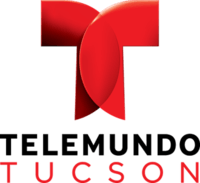KHRR
KHRR, virtual channel 40 (UHF digital channel 16), is a Telemundo owned-and-operated television station licensed to Tucson, Arizona, United States. The station is owned by the Telemundo Station Group subsidiary of NBCUniversal (itself a subsidiary of Comcast). KHRR's studios are located on North Stone Avenue in downtown Tucson, and its transmitter is located atop the Tucson Mountains.
 | |
| Tucson, Arizona United States | |
|---|---|
| Channels | Digital: 16 (UHF) Virtual: 40 (PSIP) |
| Branding | Telemundo Tucson |
| Programming | |
| Affiliations | 40.1: Telemundo (O&O) 40.2: TeleXitos 40.3: Lx |
| Ownership | |
| Owner | Telemundo Station Group (a subsidiary of NBCUniversal) (NBC Telemundo License LLC) |
| History | |
| First air date | July 1, 1992 |
| Former channel number(s) | Analog: 40 (UHF, 1992–2009) Digital: 42 (UHF, 2003–2009) 40 (UHF, 2009–2018) |
| Technical information | |
| Licensing authority | FCC |
| Facility ID | 30601 |
| ERP | 396 kW |
| HAAT | 622 m (2,041 ft) |
| Transmitter coordinates | 32°14′55.8″N 111°6′59.1″W |
| Links | |
| Public license information | (semi-satellite of KTAZ, Phoenix, Arizona) Profile LMS |
| Website | www |
Although identifying as a separate station in its own right, KHRR is considered a semi-satellite of KTAZ (channel 39) in Phoenix. As such, it simulcasts all Telemundo programming as provided through its parent, but airs separate commercial inserts and legal identifications, and has its own website. Local newscasts, produced by KTAZ and branded as Noticiero Telemundo Arizona, are simulcast on both stations. Although KHRR maintains its own facilities, master control and most internal operations are based at KTAZ's studios on South 33rd Place in Phoenix.
History
KPOL
Channel 40 was originally home to an English-language independent station, known as KPOL, which signed on the air January 5, 1985.[1] At the same time, KDTU (now KTTU) signed on with a similar format. Tucson was too small to support both stations, so KPOL filed for bankruptcy in 1988 and went dark in 1989. The license remained active.
KHRR
In 1991, local Tucson businessman Jay Zucker purchased the dormant KPOL license out of bankruptcy, and on July 1, 1992, channel 40 signed on as KHRR with Telemundo programming. Zucker owned the station until 1998, when he sold it to The Apogee Companies, who maintained the Telemundo affiliation.
KHRR became a Telemundo O&O in 2002, along with KDRX-CA (now KDPH-LP). The two stations maintained a sister relationship, sharing their newscasts and programming stations, yet with each station based out of its own city of license. The arrangement continued until a 2006 station swap relocated Telemundo O&O KPHZ to Phoenix, Arizona, where it became KTAZ, and Daystar O&O KDTP to Holbrook, Arizona. The deal also transferred KDRX-CA to Daystar, where it became KDTP-CA.
In 2007, a restructuring plan by parent company NBC Universal, called "NBCU 2.0", moved the KHRR and KTAZ newscasts to the Telemundo News Hub in Dallas, along with news operations of other Telemundo stations in the West.
Digital television
Digital channels
The station's digital signal is multiplexed:
| Channel | Video | Aspect | PSIP Short Name | Programming[2] |
|---|---|---|---|---|
| 40.1 | 1080i | 16:9 | KHRR-DT | Main KHRR programming / Telemundo |
| 40.2 | 480i | T-Xitos | TeleXitos | |
| 40.3 | LocalX | Lx |
In their Sixth Report and Order, dated April 3, 1997, proposing a digital television table of allotments, the FCC allocated UHF channel 41 for the KHRR-DT operations.[3] However, by February 1998, the DTV Table of Allotments had been changed to specify channel 42 for KHRR-DT.[4] KHRR applied for DTV facilities to broadcast at 303 kW in October 1999, and eventually amended the ERP to 411.5 kW in February 2002.[5][6] In May 2003, in order to meet an FCC deadline for having a digital television station operational, KHRR requested a Special Temporary Authorization (STA) to operate at 12.7 kW, which the FCC granted the following month.[7] After delays due to coordination with the Mexican government, interference issues, and the sale of the station from the Apogee Companies to NBC Telemundo, by June 2006, the station was still operating under their STA facilities, the STA having been extended several times. Having to meet another FCC deadline to have fully operational facilities by June 30, 2006, KHRR requested to make their STA facilities permanent.[8] The FCC granted the request on July 10, 2006, and the next day, KHRR applied for a license to cover their facilities, from which they were already broadcasting. The FCC granted the license on January 31, 2007.[9]
Analog-to-digital conversion
KHRR discontinued regular programming on its analog signal, over UHF channel 40, on June 12, 2009, as part of the federally mandated from analog to digital television.[10] The station's digital signal relocated from its pre-transition UHF channel 42 to channel 40.[11]
References
- "New Tucson TV Stations". Casa Grande Dispatch. 1984-12-31. p. 13.
- RabbitEars TV Query for KHRR
- "Proposed DTV Table of Allotments" (PDF). FCC Sixth Report and Order, Appendix B. Federal Communications Commission. 1997-04-03. p. 12. Retrieved 2007-03-24.
- "1998 Initial DTV Table of Allotments" (PDF). Memorandum Opinion and Order on Reconsideration of the Sixth Report and Order, Appendix B. Federal Communications Commission. 1998-02-17. p. 19. Retrieved March 24, 2007.
- "Original DTV application". Federal Communications Commission. 1999-10-28. Retrieved March 24, 2007.
- "Amended DTV application". Federal Communications Commission. 2002-02-21. Retrieved March 24, 2007.
- "Amended STA request" (PDF). Federal Communications Commission. 2003-08-29. p. 6. Retrieved March 24, 2007.
- "Application to make STA facilities permanent". Federal Communications Corporation. 2006-06-26. Retrieved March 24, 2007.
- "DTV license application". Federal Communications Commission. 2006-07-11. Retrieved March 24, 2007.
- http://hraunfoss.fcc.gov/edocs_public/attachmatch/DOC-288530A2.pdf
- "DTV channel election". Federal Communications Commission. 2005-02-09. Retrieved March 24, 2007.
External links
- Official website
- Telemundo website
- TeleXitos website
- KHRR in the FCC's TV station database
- BIAfn's Media Web Database -- Information on KHRR-TV